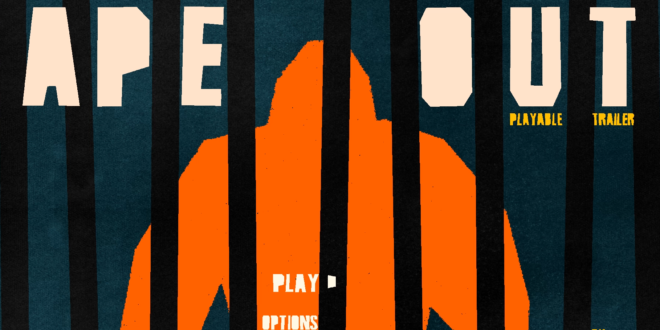On paper, Ape Out sounds like a pretty typical game: as an ape, you try to escape a heavily-guarded facility. This premise could be the starting point of many stealth or escape games. And yet, Ape Out is truly unique.

Developer Gabe Cuzzillo has managed to blend together such an incredible patchwork of ideas that you’re left wondering why has nobody done it before: Saul Bass-inspired art meets freeform jazz in what ends up being an incredibly inspired (and violent) procedurally generated beat ‘em up.
Ape Out is Cuzzillo’s second game, following up on 2014’s fencing title Foiled, which he co-developed with Aaron Taecker-Wyss.
“I was in the film program [at NYU] at the time and I started sniffing at the games department thinking about switching,” Cuzzillo tells MCV. “I finished Foiled in November [2013] and we still had however many weeks left in the semester so I had to start a new thing, and I’d been playing a lot of top down games.”
He mentions Monaco: What’s Yours Is Mine and, of course, the ultimate reference, Hotline Miami.
“I was just interested in all those games’ very minimal feel. There isn’t a huge amount of physicality to them. The characters feel light, change direction very fast, almost feel like a cursor,” he continues.
“And so I wanted to try making a top down game that had a little bit more physicality to it and a little bit more more feel. That first manifested as a stealth game where you were playing a bald guy and you were sneaking around and the idea was that the physicality was going to come from your interaction with walls. The walls were going to be the equivalent of platforms in a platformer. So you could always be moving from wall to wall and be slinking along the wall. You could also push off the walls or you could grab the walls and then lean and peek around corners.”
Being able to grab the walls was a turning point in development, Cuzzillo adds: “If you could grab walls, it made sense to be able to grab people. And then if you grab people, it makes sense to throw people. So pretty quickly it was a game where you grabbed people and pushed them into each other. Then it was: ‘Oh well, this doesn’t really make sense for a human to do. Perhaps a gorilla’. And so then I started making it into a gorilla.”
And just like that, Ape Out started taking shape. But this wasn’t necessarily an easy ride for Cuzzillo, as it took quite a long time for the title to come to life, with Ape Out not releasing until February 2019 – almost six years after it started development.
APE-LYING YOURSELF
Being quite new to making video games, Cuzzillo had to learn everything from scratch.
“[Ape Out’s development] was mostly me learning how to do anything because Foiled was made in GameMaker and it turns out I didn’t really know how to code because I’d only been coding for six months,” he smiles. “And so the first year was some design noodling but mostly just me struggling with the code and with tools, and trying to learn how to do stuff.”
Cuzzillo actually started making what would become Ape Out in GameMaker, but switched to Unity after a month or so of work. When asked about the reasons for this switch, especially considering he was still learning to code, he laughs: “I mean, there wasn’t a great reason! I had a lot of trouble launching Foiled – it wasn’t working properly on Windows 8. Unity was just the thing that everybody used and it seemed like a grown-up piece of software. It was powerful. But it’s a lot… You actually have to understand code. And it turns out I didn’t!”
Making a game in Unity without really knowing how to code sounds incredibly ambitious. Fortunately, Cuzzillo had the support of his brother, who had studied Computer Science and is “very generous with his time,” Cuzzillo jokes.

“That first summer I was making Foiled, I just learnt sitting next to him at my computer. I would just go for hours and hours and hours – at the beginning I was just really soaking it up. It was really addictive,” he says.
When he switched over to Unity for Ape Out, he had to rely on his brother whenever he got stuck, “which was a lot at the beginning,” he adds.
“There was a point after about two months of development where I was in a lecture trying to work on it and it didn’t have any Wi-Fi and I just couldn’t do anything. I could make no progress because I just had to rely on the internet and my brother so much at the beginning that I just couldn’t figure out how to make the code work without those things. So the first year or so was just really trying to get my head above water.”
This will probably sound familiar to a lot of young, self-taught developers and should probably reassure them that it is indeed possible to keep your head above water in such circumstances; it just takes time and you can’t really rush the process of making a game if you want it to be polished.
FINDING THE ZHOOSH
Having overcome these early stages of trial and error, Cuzzillo was then able to focus on other aspects of Ape Out, with the most important one – sound design and music – making its way to the game in a quite unexpected way before getting to its final form (a procedurally generated soundtrack, with each chapter of the game representing a jazz album, and each level being one track).
“After about a year of making [Ape Out], it had come together to some degree, it was recognisable, the silhouette style was in. At the time I was totally obsessed with the song You’ve Got to Have Freedom by Pharoah Sanders and I had to cut a trailer to apply to a NYU incubator program and I cut it to that song. It just worked really, really well and I had already been putting a little bit of music into the game. But it was over the course of that incubator program that I really figured out what the game was and I thought of ripping drum solos off YouTube and putting them in the game and playing cymbal crashes on kills. The art style came together a lot more and I solidified what the target was and what the styles I was drawing from were. But it was really that song gave the game its zhoosh.”
Cuzzillo played with music possibilities for a while before sound designer Matt Boch started on the project in 2017 and built the whole dynamic music system. Boch worked at Harmonix for over seven years and has been an associate professor at the NYU Game Center for the past four years.

“We were building the music and the game in parallel and it wasn’t until fairly late in development that the music system really came on line in the way it was going to be,” Cuzzillo continues explaining. “We still had just static temp tracks in until the build we sent out in August of 2018. But the music was far enough along in 2018 that we started to build things together. The titles between the levels were being driven by those little drum solos… Those were actually really fast to make and it was because all the drums are simulated live. We know when every drum hit occurs and so Matt can just offer a little drum solo and we can cook up the titles to respond really fast.”
With the music emulating the action on screen during levels, the drumming needed to complement the action without everything becoming a mess of noise.
“Basically the way the system works is that the only thing that is a direct reaction to a distinct event is the cymbal crashes when guards die and those depend on where on the screen the guard dies – it will play a different cymbal – but the rest of the drums are just based on an intensity rating,” Cuzzillo says.
“The intensity rating is generated basically by a couple of different factors like intensity events. And so the more guards on screen, the higher the intensity. Every time there’s a gunshot, the intensity is raised, every time you kill a guard, the intensity is raised. Fire on screen also raises the intensity. And the way the drums react to that is immediately the drummer starts playing the drums harder if the intensity goes up and he also starts choosing denser patterns to play. So he has a giant pool of patterns that he draws from – some of which Matt made, some of which he generated using neural networks and some of which he found on the Internet. Each one has a density rating and a similarity rating, and so it tries to start playing similar drum sequences that are denser – that just contain more hits per second.”
In an interview given to MusicTech, Boch said he created dozens of hours of drumming, with the publication saying that “players only hear about one-hundredth of the total patterns in any given playthrough of the game.”
It was important for Cuzzillo to use procedural generation, he continues, even if it made the process a bit more complicated than a traditional soundtrack.
“Well it’s really the reactivity…,” he answers when asked why he decided to go for procedural generation. “Because every hit is playing a sample, every drum simulates its own sound, it just means that the drum is going to be way more reactive to what’s going on. And in the game it’s so fast. The typical approach to reactive music, having stems that come in and out or fading between tracks, is just way too slow for this game.”
“It took me a long time to figure out what the fuck should happen at the end of a level. It just didn’t have the flair that the rest of the game had.”
On top of this, Cuzzillo had to nail the challenge of getting the musical level transitions right.
“Until pretty late in development the level transitions were a big sticking point – they were just bad,” he says. “And I didn’t really know what to do about it. Like you would just walk into a hall and then the camera would zoom in on the ape and you’d get a score and then it would be a long loading page and then you would be in the next level and it just felt very… It just didn’t have the flair that the rest of the game had. So it took me a long time to figure out what the fuck should happen at the end of a level. Making a whole level seamless was really hard technically but worthwhile. And then the titles [between levels] really felt like they just tied the whole game together in a way that was just way more complete and seamless than the game was before.”
The art style came together around the same time, with the developer ultimately working with QWOP creator Bennett Foddy, who had just started teaching game design at NYU when Cuzzillo started working on Ape Out.
“The art style, at the very start, was me trying to find a style that fits the vibe of the game and was something that I could accomplish as a non-artist. So I started looking at a lot of Saul Bass and Olly Moss posters and once the music started coming in, everything clicked and it became clear the era and vibe we were evoking.
“Ben [Foddy] was always, first as a professor and then as a peer, helping out with art stuff and giving advice about how to make the game look better. But it wasn’t until the last couple months of development that he actually came on the project and basically he just spent three months adding a lot of richness to the environments, he just made a lot of props and adjusted all the colour palettes, and also did the beautiful album covers and the menu art.”
AN UNCONFIDENT STATE
Looking back, there are a couple of things Cuzzillo would do differently, he says, also mentioning how difficult it is to finish a game and to face what the game is compared to your own expectations of what the game could have been.
“I wouldn’t try to do it alone,” he starts saying. “I was alone with the project for a long time. In some ways that was good but I think it was just too long. And then there was just a couple of years here and there, like 2016 and 2017 namely, where I just didn’t make as much progress as I was hoping and the game… I just wasn’t really… I didn’t know how to
finish it.
“I had a part of it and I knew that part was working but I didn’t know how to expand it into a full game and I didn’t know what it meant to finish a game because I hadn’t really done it – at least this style of game – before.
“I think I was imagining that finishing it had to entail things I didn’t really know how to do. I thought there were gonna be elaborate cutscenes and more story stuff. I half built a lot of those things. But I don’t know, it was like something happened at some point where it clicked and I somehow entered finishing mode.”
“I had a part of it but I didn’t know what it meant to finish a game. I was imagining that finishing it had to entail things I didn’t really know how to do.”
Ape Out’s publisher Devolver Digital’s head of production Andrew Parsons came to New York to help Cuzzillo make a milestone schedule towards the end of 2017 – which probably gave the developer the little push he needed.
“I came into 2018 having had [Ape Out] over my head for way too long and I just wanted the game to be finished by May of 2018. And I didn’t really know what that meant. By that point, I knew there were going to be albums and I had rough outlines of what the albums were going to be. But at a certain point I was like: ‘OK well I have to have the whole game playable by the end of February. What is the thing I could do that would make that at all doable?’.”
He concludes: “It’s weird because actually a lot of work I did during that time I ended up redoing later. It’s like I somehow had to just get enough of it down even in an unconfident state just to be able to understand what the pieces were and what were the parts actually required, what the intentions were. Because it just lived in a very conceptual space for a long time, where I didn’t really know what we were actually working on and ended up just working on stuff that was not really the best and most relevant stuff. A lot.”

 MCV/DEVELOP News, events, research and jobs from the games industry
MCV/DEVELOP News, events, research and jobs from the games industry




